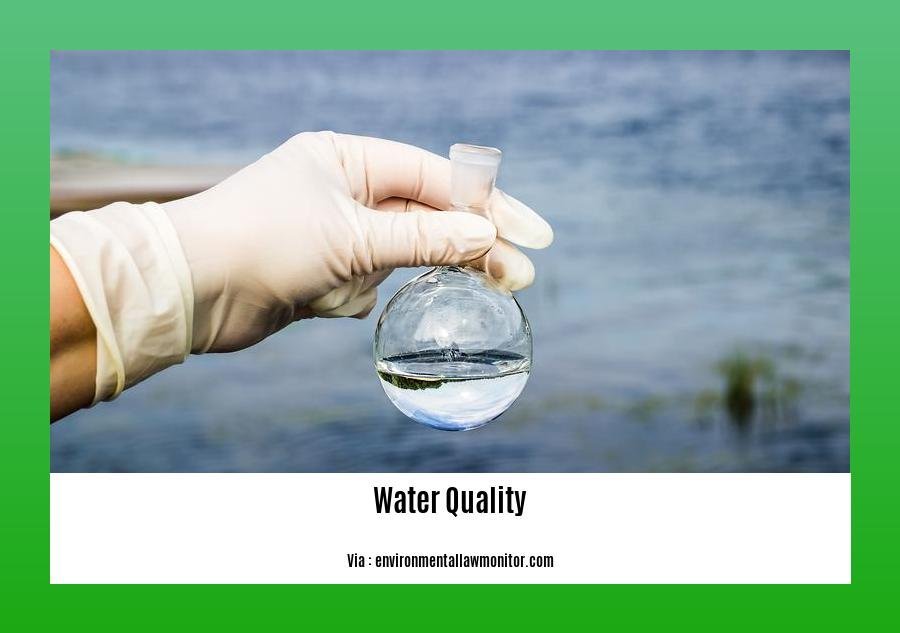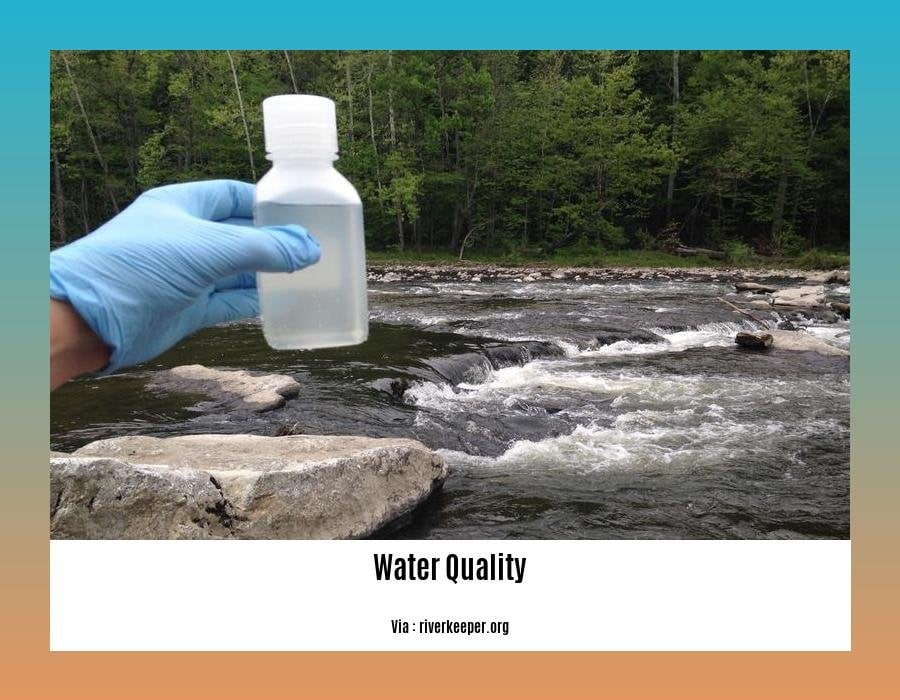Exploring the Significance of Common Water Quality Tests: Ensuring Safety and Purity
In today’s world, where access to clean and safe water is of utmost importance, understanding the significance of common water quality tests becomes crucial. Whether it is for our drinking water sources or the preservation of aquatic ecosystems, these tests play a vital role in assessing the safety and purity of our water resources. As an experienced environmental scientist specializing in water quality assessments, I have witnessed firsthand the invaluable insights these tests provide. Through years of fieldwork and research, I have come to appreciate the careful analysis and meticulous laboratory skills required to identify potential contaminants and ensure the well-being of individuals and communities. By unraveling the implications of these essential tests, we can work towards advocating sustainable practices and safeguarding public health.
Key Takeaways:
- Physical tests are used to assess the visual appearance, taste, odor, and temperature of water.
- Chemical tests are employed to measure the amounts of mineral and organic substances in water that can impact its quality.
- Bacteriological tests are conducted to identify the presence of bacteria, especially those associated with fecal pollution, in water.
- Water sampling is essential for monitoring water quality and ensuring it meets safety standards for drinking.
- Testing procedures for water quality involve sampling, testing, and analysis, which vary based on the specific parameters being assessed.
- Water treatment methods aim to produce safe drinking water, with the extent of treatment varying depending on water usage needs.
- Harbor masters can employ investigative analysis to prevent contamination and disease outbreaks in fishing harbors.
- Basic water quality tests provide information about the health of rivers, creeks, and wetlands.
- Chemical tests are commonly used in low-budget, portable field test methods for monitoring water quality.
- The U.S. Geological Survey utilizes various water sampling techniques to assess the quality of streams, rivers, and lakes.
- Filtration is a widely used water quality testing method in both the filtration industry and domestic sector.
Common Water Quality Tests

Water is a vital resource that sustains life, and ensuring its safety and purity is of utmost importance. Common water quality tests play a crucial role in assessing the health and cleanliness of our drinking water sources. By understanding the significance and implications of these tests, we can take proactive measures to protect public health and advocate for sustainable practices. In this article, we will delve into the various types of tests used to evaluate water quality, their purpose, and how they contribute to ensuring safe and pure drinking water.
Physical Tests: Senses Unveil Clues
The first set of tests used to evaluate water quality are physical tests. These tests rely on our senses to detect properties of water that can be readily sensed, such as its appearance, taste, odor, and temperature. By carefully observing these characteristics, scientists can gather valuable information about potential contamination or changes in water quality.
Think about it – when you take a sip from a glass of water, the taste, smell, and even the clarity of the water give you immediate feedback about its quality. These physical tests provide us with a preliminary understanding of water quality, acting as our first line of defense in identifying any abnormalities.
Chemical Tests: Digging Deeper
While physical tests provide valuable insights, they do not provide a comprehensive assessment of water quality. This is where chemical tests come into play. Chemical tests are crucial in determining the amounts of mineral and organic substances present in water that can affect its quality. By analyzing specific chemical compounds and elements, scientists can identify potential contaminants and assess their levels in the water.
Chemical tests enable us to detect various substances such as heavy metals, synthetic chemicals, nutrients, and organic compounds that may pose risks to human health and the environment. By regularly conducting these tests, we can identify potential sources of contamination and take necessary corrective actions to ensure the safety and purity of our drinking water sources.
Bacteriological Tests: Uncovering Hidden Threats
Besides physical and chemical tests, bacteriological tests are used to identify the presence of bacteria in water, particularly those associated with fecal pollution. Bacteria such as E. coli and coliforms can indicate the presence of contamination from human and animal waste, posing significant health risks if consumed.
Bacteriological tests play a critical role in monitoring water quality, as they help identify potential sources of contamination and assess the effectiveness of water treatment processes. By pinpointing the presence of harmful bacteria, these tests allow us to take proactive measures to protect against waterborne diseases and ensure the purity of our drinking water.
Water Sampling: The Gateway to Assessment
To conduct these tests effectively, water sampling is crucial. Water sampling involves collecting representative samples from various sources such as rivers, lakes, and groundwater wells. These samples are then subjected to laboratory testing and analysis to evaluate their quality.
The selection of sampling locations, frequency, and methods is crucial to obtain accurate and reliable data. By adhering to standardized protocols and guidelines, scientists ensure that the sampling process is rigorous and representative of the water source being evaluated. Through meticulous sampling, we gain valuable insights into water quality, enabling us to make informed decisions regarding water treatment and resource management.
Testing Procedures: The Roadmap to Assessments
The process of water quality assessment involves multiple steps – sampling, testing, and analysis. Testing procedures can vary depending on the specific parameters being assessed. From physical observations to laboratory analysis, a comprehensive approach is necessary to obtain a holistic understanding of water quality.
For example, filtration, a common testing method, involves the separation of suspended particles from water using porous materials. This process helps identify and quantify the level of particulate matter present in the water, providing insights into its cleanliness and turbidity. Other testing procedures may involve chemical analyses, microscopy, or specific assays targeting bacteria or contaminants of concern.
Water Treatment: Safeguarding Our Health
While water quality tests play a crucial role in identifying potential threats, an effective water treatment process is equally essential. Water treatment methods ensure that raw water is treated to produce water of potable quality, safe for human consumption.
The extent of treatment required depends on various factors such as the specific water usage needs and the presence of contaminants. By utilizing advanced treatment technologies and adhering to regulatory standards, water treatment plants can effectively remove or reduce harmful substances, providing us with safe and pure drinking water.
Conclusion
Common water quality tests are an essential component of ensuring the safety and purity of our drinking water sources. By conducting physical, chemical, and bacteriological tests, and adhering to standardized sampling and testing procedures, we can identify potential threats, evaluate water quality, and take necessary actions to protect public health.
Remember, our senses can provide valuable clues, but in-depth chemical and bacteriological analyses are necessary to obtain a comprehensive understanding of water quality. Let us work together to advocate for sustainable practices and prioritize the monitoring of water quality. By doing so, we can ensure that future generations have access to safe and pure drinking water for years to come.
Water pollution is a pressing issue in the Philippines. Discover the causes of water pollution in the Philippines and how it affects the environment and the health of its population here.
Water pollution is also a concern in Zambia. Find out more about the causes of water pollution in Zambia and the impact it has on the country’s ecosystems and communities here.
While water conservation is important, it’s crucial to understand the potential downsides. Learn about the cons of water conservation and the potential challenges it presents here.
Significance of Testing for Chemical Parameters

Chemical measures play a vital role in assessing the quality of water and ensuring its safety and purity. These measures help in detecting pollutants and imbalances within the ecosystem, providing valuable insights into the overall health of water sources. By testing the levels of various elements and molecules, we can identify potential threats to public health and advocate for sustainable practices. Let’s explore the significance of testing for chemical parameters in water quality assessment.
Why Are Chemical Measures Important?
Chemical measures are necessary for identifying pollutants such as lead or mercury in water sources. These measures help us understand the presence and concentration of harmful substances that can have adverse effects on human health and the environment. By directly detecting these pollutants, we can take the necessary steps to mitigate their impact and ensure the safety of drinking water.
Moreover, chemical measures not only detect specific pollutants but also indicate imbalances within the ecosystem. An imbalance in the chemical composition of water can have far-reaching consequences, affecting the entire ecosystem and its inhabitants. By monitoring chemical parameters, we can identify and address these imbalances, safeguarding the health and integrity of the ecosystem.
Physico-Chemical Parameters: Key Information for Water Quality Assessment
To assess water quality, various physico-chemical parameters are considered. These parameters provide valuable information about the composition and characteristics of water. Some important physico-chemical parameters include color, temperature, acidity, hardness, pH, sulphate, chloride, dissolved oxygen (DO), biochemical oxygen demand (BOD), chemical oxygen demand (COD), and alkalinity.
These parameters help us evaluate the suitability of water for various purposes, such as drinking, irrigation, and industrial use. By testing and analyzing these parameters, we can determine the overall quality of water and identify any potential risks associated with its use.
Identifying Suitable Household Water Treatment Technologies
Water quality testing is crucial for selecting the most suitable household water treatment (HWT) technology for a specific area. Since no water source is completely pure, testing allows us to understand the naturally occurring chemicals present in the water. By identifying these chemicals, we can customize water treatment technologies to effectively remove or mitigate potential contaminants, ensuring access to safe and clean drinking water.
Testing Procedures: Assessing Water Quality from Multiple Angles
Testing procedures for water quality can be categorized into physical, chemical, bacteriological, and microscopic tests. Each of these tests serves a specific purpose in evaluating water quality.
Physical tests focus on properties detectable by the senses, such as appearance, taste, odor, and temperature. These tests provide initial insights into water quality and can help in identifying obvious issues.
Chemical tests determine the amounts of mineral and organic substances affecting water quality. Through chemical analyses, we can quantify the presence of pollutants and evaluate their potential impact on human health and the environment.
Bacteriological tests evaluate microbial contamination, particularly bacteria associated with fecal pollution. These tests indicate the presence of harmful microorganisms that can cause waterborne diseases and inform the effectiveness of water treatment processes.
Microscopic tests examine various organisms and particles in the water. By observing microscopic organisms and particles, we can understand their presence and abundance, giving us further insights into water quality and ecosystem health.
By combining these testing procedures, we can obtain a comprehensive understanding of water quality, identifying potential risks and taking appropriate measures to ensure its safety and purity.
Key Takeaways:
- Chemical measures play a crucial role in assessing water quality and detecting pollutants and imbalances within the ecosystem.
- Physico-chemical parameters provide valuable information about the quality of water and its suitability for various purposes.
- Water quality testing is essential for identifying suitable household water treatment technologies and ensuring access to safe drinking water.
- Testing procedures encompass physical observations, chemical analyses, microscopy, and specific assays, each serving a specific purpose in evaluating water quality.
Sources:
– Chemical Measures for Water Quality Assessment
– Physico-chemical Parameters for Water Testing
Understanding Microbial Testing and Its Implications
Microbial testing plays a crucial role in assessing the safety and purity of drinking water sources. By examining the presence and concentration of microorganisms, especially those associated with fecal pollution, this testing provides valuable insights into potential contamination and the effectiveness of water treatment processes. Let’s dive deeper into understanding microbial testing and its implications.
The Importance of Microbial Water Quality Testing
Microbial water quality refers to the microbiological conditions of water in relation to human and animal health requirements. It involves the detection, monitoring, prediction, and management of pathogenic contamination. Such testing is essential for ensuring the safety of drinking water supplies and protecting public health.
Short-term fluctuations in microbial water quality can occur rapidly and widely, posing significant risks for disease transmission. Increasing pathogen concentrations during these peaks can compromise the safety of drinking water. Therefore, routine microbiological testing is vital to identify potential threats and make informed decisions regarding water treatment and distribution management.
Challenges and Solutions
Conducting sufficient microbial water quality testing can be challenging, especially in low-resource settings. Limited access to laboratory facilities, trained personnel, and financial resources can hinder comprehensive monitoring efforts. Nevertheless, efforts to overcome these challenges are essential for ensuring safe drinking water access for all.
Advances in technology have paved the way for innovative solutions. Compact and portable testing equipment, simplified test procedures, and training initiatives can help overcome the limitations faced by low-resource settings. Additionally, establishing partnerships between governments, organizations, and communities can strengthen the capacity for water quality testing and monitoring.
Interpreting Test Results and Implications for Public Health
Understanding microbial indicators is crucial for interpreting test results and assessing the public health significance of drinking water. The presence of specific microorganisms, such as fecal coliforms and E. coli, indicate potential contamination by fecal matter and the possible presence of other pathogenic microorganisms.
Proper interpretation of test results allows for appropriate actions to be taken to address any contamination issues. Whether it’s implementing additional water treatment measures, adjusting distribution systems, or issuing public health advisories, understanding the implications of microbial testing is essential for safeguarding public health.
Key Takeaways:
- Microbial water quality testing is vital for assessing the safety of drinking water sources and protecting public health.
- Fluctuations in microbial water quality can pose disease risks and compromise the safety of drinking water.
- Conducting sufficient testing can be challenging, particularly in low-resource settings, but innovative solutions and collaborations can help overcome these obstacles.
- Interpreting test results, particularly microbial indicators, is crucial for understanding contamination risks and taking appropriate actions to ensure water safety.
Sources:
1. National Center for Biotechnology Information
Interpreting Water Quality Test Results
When it comes to ensuring the safety and purity of our drinking water, understanding the results of water quality tests is crucial. Water quality tests provide valuable insights into the current state of our water sources and can help identify potential issues that may pose a risk to public health. In this article, we will explore the significance of common water quality tests and how to interpret their results.
The Importance of Water Quality Tests
Water quality tests allow us to assess the health and cleanliness of our drinking water sources. These tests encompass a range of parameters that provide a comprehensive picture of the water’s quality. Some of the important tests include measuring pH levels, alkalinity, hardness, saturation index (SI), electrical conductivity (EC), sodium adsorption ratio (SAR), and chloride levels. Each test plays a crucial role in identifying potential contaminants or imbalances in the water.
To ensure accurate and reliable results, it is recommended to have these tests conducted by a certified laboratory. Certified laboratories follow standardized protocols and have the necessary equipment and expertise to perform the tests accurately.
Interpreting Water Test Results
Interpreting water test results requires considering the concentrations of contaminants and their units of measurement. A comprehensive water analysis report typically includes parameters grouped into three categories: health risk parameters, general indicators, and nuisance parameters.
Health risk parameters are related to potential risks to human health and include tests for bacteria, viruses, and chemical contaminants such as lead or mercury. General indicators provide insights into overall water quality and include parameters like pH, alkalinity, hardness, and conductivity. Nuisance parameters may not directly impact human health but can affect the taste or appearance of water, and include factors like color, odor, and turbidity.
When interpreting the test results, it is essential to compare the values obtained with established regulatory guidelines or standards. These standards vary depending on the country or region. If any parameter exceeds the recommended limit, appropriate actions, such as water treatment or further investigation, should be taken to address the issue and ensure the safety of the water source.
Key Takeaways:
- Water quality tests are crucial for assessing the safety and purity of drinking water sources.
- pH levels, alkalinity, hardness, saturation index (SI), electrical conductivity (EC), sodium adsorption ratio (SAR), and chloride levels are important parameters to consider in water quality tests.
- Certified laboratories should conduct these tests for accurate results.
- Interpreting water test results involves considering the concentrations of contaminants and their units of measurement.
- Water analysis reports typically include health risk parameters, general indicators, and nuisance parameters.
- Comparing test results with established regulatory guidelines helps determine if any issues need to be addressed for water safety.
Citations:
– Interpreting water quality test results – NSW Department of Primary Industries
– How to Interpret a Water Analysis Report – Penn State Extension
FAQ
Q1: Why are water quality tests important?
A1: Water quality tests are important because they help assess the safety and purity of drinking water sources. They detect contaminants, imbalances within the ecosystem, and microbial contamination, helping to protect public health and ensure the well-being of the environment.
Q2: What are the different types of water quality tests?
A2: There are several types of water quality tests, including physical tests that examine properties like appearance and temperature, chemical tests that determine the levels of mineral and organic substances, bacteriological tests that identify bacterial contamination, and microscopic tests that analyze organisms and particles in the water.
Q3: How do chemical measures help in assessing water quality?
A3: Chemical measures play a crucial role in assessing water quality by detecting pollutants such as lead or mercury. They involve testing the levels of various elements and molecules dissolved or suspended in the water, providing valuable information about the quality of the water.
Q4: What are some common physico-chemical parameters used in water quality testing?
A4: Common physico-chemical parameters used in water quality testing include color, temperature, acidity, hardness, pH, sulphate, chloride, dissolved oxygen (DO), biochemical oxygen demand (BOD), chemical oxygen demand (COD), and alkalinity. These parameters provide insights into the quality of the water being tested.
Q5: Who should conduct water quality tests?
A5: It is recommended to have a certified laboratory conduct water quality tests for accurate results. Certified laboratories have the expertise, equipment, and knowledge to perform the tests according to standardized procedures, ensuring reliable and trustworthy results.
- Unlock Filipino Culture: A Deep Dive into Traditions and Practices - April 23, 2025
- Unlock Spanish Culture: Insights & Opportunities Now - April 23, 2025
- White Spirit Uses & Substitutes: A Deep Dive for Pros & DIYers - April 23, 2025
















